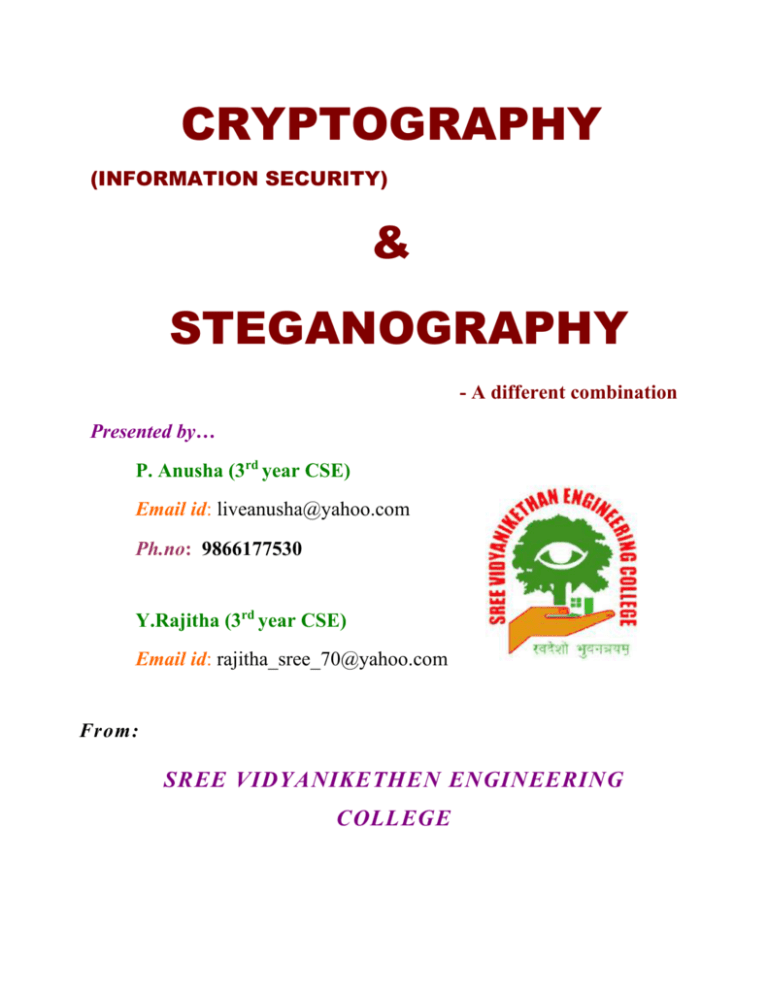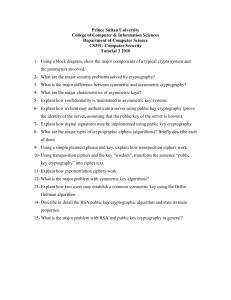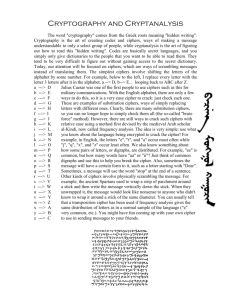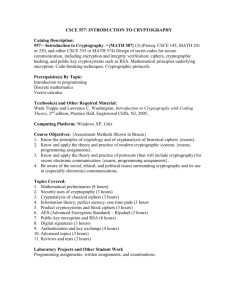CRYPTOGRAPHY (INFORMATION SECURITY)
advertisement

CRYPTOGRAPHY (INFORMATION SECURITY) & STEGANOGRAPHY - A different combination Presented by… P. Anusha (3rd year CSE) Email id: liveanusha@yahoo.com Ph.no: 9866177530 Y.Rajitha (3rd year CSE) Email id: rajitha_sree_70@yahoo.com From: SREE VIDYANIKETHEN ENGINEERING COLLEGE Cryptography or Cryptology is derived from Abstract: Greek, which means the practice and study of hiding This paper is about CRYPTOGRAPHY and information. In modern times, cryptography is STEGANOGRAPHY– the science of scrambling considered to be a branch of both mathematics and data and the art of being invisible are used to make it computer science, and is affiliated closely with unintelligible to all, except the intended person, and information its various methods in making the work look more engineering. Cryptography is used in applications perfect. Cyber crimes have become a common piece present of vandalism in the present computerized world. especially What has changed dramatically is the ability to importance. in theory, computer technologically where data security, advanced security has and societies; highest tamper with information. In a society where information is mostly stored and transmitted in Until modern times, cryptography referred electronic form, what has become an absolute must is almost exclusively to encryption, the process of a means to ensure information security that is converting ordinary information (plaintext) into independent medium unintelligible gibberish. Decryption is the reverse, responsible for generating or storing it. Today, there moving from unintelligible cipher text to plaintext. A is an immediate need to delve into the clutter of cipher (or cipher) is a pair of algorithms which material. There are many laws in enforcement and perform this encryption and the reversing decryption. many new devices, which are used to prevent such The detailed operation of a cipher is controlled both crimes. Nevertheless, these all devices resemble a by the algorithm and, in each instance, by a key. This seismograph, which records the amount of quake but is a secret parameter (ideally, known only to the cannot prevent the same. Here comes the discussion communicants) for a specific message exchange on cryptography, which plays a major role in this context. Keys are important, as ciphers without field of security of sending messages? variable keys are trivially breakable and therefore of the actual physical less than useful for most purposes. Historically, Steganography is the art and science of ciphers were often used directly for encryption or writing hidden messages in such a way that no one decryption, without additional procedures such as apart from the sender and intended recipient even authentication or integrity checks. realizes there is a hidden message. By contrast, cryptography obscures the meaning of a message, but it does not conceal the fact that there is a message. Today, the term steganography includes the concealment of digital information within computer files. In colloquial use, the term "code" is often used to mean any method of encryption or concealment of meaning. However, in cryptography, code has a more specific meaning; it means the replacement of a unit of plaintext (i.e., a meaningful word or phrase) with a code word (for example, apple pie replaces attack at dawn). Codes are no longer Introduction used in serious cryptography—except incidentally for such things as unit designations (egg: 'Bronco Flight' or Operation Overlord) —- since properly chosen Simple versions of either offered little confidentiality ciphers are both more practical and more secure than from enterprising opponents, and still don't. An early even the best codes, and better adapted to computers substitution cipher was the Caesar cipher, in which as well. each letter in the plaintext was replaced by a letter some fixed number of positions further down the History of cryptography and cryptanalysis alphabet. It was named after Julius Caesar who is reported to have used it, with a shift of 3, to communicate with his generals during his military The Ancient Greek scytale (rhymes with Italy), probably much like this modern campaigns, just like EXCESS-3 code in boolean algebra. reconstruction, may have been one of the earliest devices used to implement a cipher. Various physical devices and aids have been used to assist with ciphers. One of the earliest may Before the modern era, cryptography was concerned solely with message confidentiality (i.e., encryption) — conversion of messages from a comprehensible form into an incomprehensible one, and back again at the other end, rendering it unreadable by interceptors or eavesdroppers without secret knowledge (namely, the key needed for decryption of that message). In recent decades, the field has expanded beyond confidentiality concerns to include techniques for message integrity checking, sender/receiver signatures, identity interactive authentication, digital proofs, secure and computation, amongst others. have been the scytale of ancient Greece, a rod supposedly used by the Spartans as an aid for a transposition cipher. In medieval times, other aids were invented such as the cipher grille, also used for a kind of steganography. With the invention of polyalphabetic ciphers came more sophisticated aids such as Alberti's own cipher disk, Johannes Trithemius' tabula recta scheme, and Thomas Jefferson's multi-cylinder (reinvented independently by Bazeries around 1900). Several mechanical encryption/decryption devices were invented early in the 20th century, and many patented, including rotor machines — most famously the Enigma machine The earliest forms of secret writing required used by Germany in World War II. The ciphers little more than local pen and paper analogs, as most implemented by better quality examples of these people could not read. More literacy, or opponent designs brought about a substantial increase in literacy, required actual cryptography. The main cryptanalytic difficulty after WWI. classical cipher types are transposition ciphers, which rearrange the order of letters in a message (e.g. 'help me' becomes 'help em' in a trivially simple rearrangement scheme), and substitution ciphers, which systematically replace letters or groups of letters with other letters or groups of letters (e.g., 'fly at once' becomes 'gmz bu podf' by replacing each letter with the one following it in the alphabet). The development of digital computers and electronics after WWII made possible much more complex ciphers. Furthermore, computers allowed for the encryption of any kind of data that is represented by computers in any binary format, unlike classical ciphers which only encrypted written language texts, dissolving the utility of a linguistic approach to cryptanalysis in many cases. Many computer ciphers patterns. Since then the emphasis has shifted, and can be characterized by their operation on binary bit cryptography sequences (sometimes in groups or blocks), unlike mathematics, including aspects of information theory, classical and mechanical schemes, which generally computational complexity, statistics, combinatorics, manipulate traditional characters (i.e., letters and abstract algebra, and number theory. Cryptography is digits) directly. However, computers have also also a branch of engineering, but an unusual one as it assisted cryptanalysis, which has compensated to deals with active, intelligent, and some extent for increased cipher complexity. opposition Nonetheless, good modern ciphers have stayed ahead security of cryptanalysis; it is usually the case that use of a engineering need deal only with neutral natural quality cipher is very efficient (i.e., fast and requiring forces. now (see makes extensive cryptographic engineering); most use malevolent engineering other of kinds and of few resources), while breaking it requires an effort many orders of magnitude larger, Modern cryptography making cryptanalysis so inefficient and impractical as to be effectively impossible. The modern field of cryptography can be divided into several areas of study. Extensive open academic research into cryptography is relatively recent — it began only in the mid-1970s with the public specification of DES • Symmetric-key cryptography Symmetric-key cryptography refers to (the Data Encryption Standard) by the NBS, the encryption methods in which both the sender and Diffie-Hellman paper,and the public release of the receiver share the same key (and, less commonly, in RSA algorithm. Since then, cryptography has become which their keys are different, but related in an easily a widely used tool in communications, computer computable way).The modern study of symmetric- networks, and computer security generally. The key ciphers relates mainly to the study of block present security level of many modern cryptographic ciphers and stream ciphers and to their applications. techniques is based on the difficulty of certain A block cipher is, in a sense, a modern embodiment computational integer of Alberti's polyalphabetic cipher: block ciphers take factorisation problem or the discrete logarithm as input a block of plaintext and a key, and output a problem. In many cases, there are proofs that block of cipher text of the same size. Since messages cryptographic techniques are secure if a certain are almost always longer than a single block, some computational problem cannot be solved efficiently. method of knitting together successive blocks is With one notable exception—the one-time pad— required. Several have been developed, some with these proofs are contingent, and thus not definitive, better security in one aspect or another than others. but are currently the best available for cryptographic They are the mode of operations and must be algorithms and protocols. carefully considered when using a block cipher in a problems, such as the cryptosystem. Essentially, prior to the early 20th century, cryptography was chiefly concerned with linguistic The Data Encryption Standard (DES) and • Public-key cryptography the Advanced Encryption Standard (AES) are block cipher designs which have been Symmetric-key cryptosystems typically use designated cryptography standards by the US government (though DES's designation was finally withdrawn after the AES was adopted).Despite its deprecation as an official standard, DES (especially its stillapproved and much more secure triple-DES variant) remains quite popular; it is used across a wide range of applications, from ATM encryption to e-mail privacy and secure remote access.Many other block ciphers have been designed and released, with considerable variation in quality. Many have been thoroughly broken. See Category:Block ciphers. the same key for encryption and decryption, though this message or group of messages may have a different key than others. A significant disadvantage of symmetric ciphers is the key management necessary to use them securely. Each distinct pair of communicating parties must, ideally, share a different key, and perhaps each ciphertext exchanged as well. The number of keys required increases as the square of the number of network members, which very quickly requires complex key management schemes to keep them all straight and secret. The difficulty of establishing a secret key between two communicating Stream ciphers, in contrast to the 'block' parties, when a secure channel doesn't already exist type, create an arbitrarily long stream of key material, between them, also presents a chicken-and-egg which is combined with the plaintext bit-by-bit or problem which is a considerable practical obstacle for character-by-character, somewhat like the one-time cryptography users in the real world. pad. In a stream cipher, the output stream is created based on an internal state which changes as the cipher Cryptanalysis operates. That state's change is controlled by the key, The goal of cryptanalysis is to find some and, in some stream ciphers, by the plaintext stream weakness or insecurity in a cryptographic scheme, as well. RC4 is an example of a well-known stream thus cipher; see Category:Stream ciphers. Cryptanalysis might be undertaken by a malicious Cryptographic hash functions (often called message digest functions) do not necessarily use keys, but are a related and important class of cryptographic algorithms. They take input data (often an entire message), and output a short, fixed length hash, and do so as a one-way function. For good ones, collisions (two plaintexts which produce the same hash) are extremely difficult to find. Message authentication codes (MACs) are much like cryptographic hash functions, except that a secret key is used to authenticate the hash value on receipt. permitting its subversion or evasion. attacker, attempting to subvert a system, or by the system's designer (or others) attempting to evaluate whether a system has vulnerabilities, and so it is not inherently a hostile act. In modern practice, however, cryptographic algorithms and protocols must be carefully examined and tested to offer any assurance of the system's security (at least, under clear — and hopefully reasonable — assumptions). It is a commonly held misconception that every encryption method can be broken. In connection with his WWII work at Bell Labs, Claude Shannon proved that the one-time pad cipher is unbreakable, provided the key material is truly "Cryptanalysis" is also used to refer to any random, never reused, kept secret from all possible attempt to circumvent the security of other types of attackers, and of equal or greater length than the cryptographic algorithms and protocols in general, message. Most ciphers, apart from the one-time pad, and not just encryption. However, cryptanalysis can be broken with enough computational effort by usually excludes attacks that do not primarily target brute force attack, but the amount of effort needed weaknesses in the actual cryptography; methods such may be exponentially dependent on the key size, as as bribery, physical coercion, burglary, keystroke compared to the effort needed to use the cipher. In logging, and so forth, although these latter types of such cases, effective security could be achieved if it attack are an important concern in computer security, is proven that the effort required (ie, 'work factor' in and are often more effective than traditional Shannon's terms) is beyond the ability of any cryptanalysis. adversary. This means it must be shown that no Even though the goal has been the same, the efficient method (as opposed to the time-consuming brute force method) can be found to break the cipher. Since no such showing can be made currently, as of today, the one-time-pad remains the only methods and techniques of cryptanalysis have changed drastically through the history of cryptography, adapting to increasing cryptographic complexity, ranging from the pen-and-paper methods theoretically unbreakable cipher. of the past, through machines like Enigma in World There are a wide variety of cryptanalytic War II, to the computer-based schemes of the attacks, and they can be classified in any of several present. The results of cryptanalysis have also ways. A common distinction turns on what an changed — it is no longer possible to have unlimited attacker knows and what capabilities are available. In success in code breaking, and there is a hierarchical a ciphertext-only attack, the cryptanalyst has access classification of what constitutes a rare practical only to the ciphertext (good modern cryptosystems attack. In the mid-1970s, a new class of cryptography are usually effectively immune to ciphertext-only was introduced: asymmetric cryptography. Methods attacks). In a known-plaintext attack, the cryptanalyst for breaking these cryptosystems are typically has access to a ciphertext and its corresponding radically different from before, and usually involve plaintext (or to many such pairs). In a chosen- solving carefully-constructed problems in pure plaintext attack, the cryptanalyst may choose a mathematics, plaintext and learn its corresponding ciphertext factorization. the best-known being integer (perhaps many times); an example is gardening, used by the British during WWII. Finally, in a chosen- Cryptographic protocols ciphertext attack, the cryptanalyst may choose ciphertexts and learn their corresponding plaintexts.[7] Also important, often overwhelmingly so, are mistakes (generally in the design or use of one of the protocols involved; see Cryptanalysis of the Enigma for some historical examples of this). In many cases, cryptographic techniques involve back and forth communication among two or more parties in space (eg, between the home office and a branch office) or across time (e.g., STEGANOGRAPHY cryptographically protected backup data). The term cryptographic protocol captures this general idea. Cryptographic protocols have -The art of being invisible been developed for a wide range of problems, including relatively simple ones like interactive proof systems,zero-knowledge, and much more complex The word steganography is of Greek origin ones like electronic cashand secure multiparty and means "covered, or hidden writing". Its ancient computation. origins can be traced back to 440 BC. Herodotus mentions two examples of steganography in. When the security of a good cryptographic Demeratus sent a warning about a forthcoming attack system fails, it is rare that the vulnerability leading to to Greece by writing it on a wooden panel and the breach will have been in a quality cryptographic covering it in wax. Wax tablets were in common use primitive. Instead, weaknesses are often mistakes in then as re-usable writing surfaces, sometimes used the protocol design (often due to inadequate design for shorthand. Another ancient example is that of procedures, or less than thoroughly informed Histiaeus, who shaved the head of his most trusted designers), in the implementation (e.g., a software slave and tattooed a message on it. After his hair had bug), in a failure of the assumptions on which the grown the message was hidden. The purpose was to design was based (e.g., proper training of those who instigate a revolt against the Persians. Later, Johannes will be using the system), or some other human error. Trithemius’s book Steganographia is a treatise on Many cryptographic protocols have been designed cryptography. and analyzed using ad hoc methods, but they rarely have any proof of security. Methods for formally Generally, a steganographic message will analyzing the security of protocols, based on appear to be something else: a picture, an article, a techniques from mathematical logic (see for example shopping list, or some other message. This apparent BAN logic), and more recently from concrete message is the cover text. For instance, a message security principles, have been the subject of research may be hidden by using invisible ink between the for the past few decades.Unfortunately, to date these visible lines of innocuous documents. tools have been cumbersome and are not widely used for complex designs. The advantage of steganography over cryptography alone is that messages do not attract The study of how best to implement and integrate cryptography in applications is itself a distinct field, see: cryptographic engineering and security engineering. attention to themselves, to messengers, or to recipients. An unhidden coded message, no matter how unbreakable it is, will arouse suspicion and may in itself be incriminating, as in countries where encryption is illegal. Often, steganography and cryptography are used together to ensure security of the covert message. Steganography used in electronic file systems, add random looking padding communication include steganographic coding inside bytes at the end of a cipher text so that its of a transport layer, such as an MP3 file, or a size cannot be used to figure out the size of protocol, such as UDP. the original plaintext. Examples of software that use this technique include FreeOTFE Steganographic message (the plaintext) is and True Crypt. often first encrypted by some traditional means, Chaffing and winnowing producing a cipher text. Then, a cover text is Invisible ink modified in some way to contain the cipher text, Null ciphers resulting in stegotext. For example, the letter size, Concealed messages in tampered executable spacing, typeface, or other characteristics of a cover files, exploiting redundancy in the i386 text can be manipulated to carry the hidden message; only the recipient (who must know the technique instruction set. used) can recover the message and then decrypt it. Francis Bacon is known to have suggested such a material A new steganographic technique involves Delays in key presses in some applications (telnet or remote desktop software) can mean a delay in packets, and the delays in the packets can be used to encode data. Modern Steganography entered the world in There is no extra processor or network 1985 with the advent of the Personal Computer steganography video sent over the network from the keyboard. Modern steganographic techniques classical in injecting imperceptible delays to packets Steganographic techniques to pictures (optionally played at slower or faster speed). technique to hide messages. applied Embedded activity, so the steganographic technique is problems. "invisible" to the user. This kind of Development following that was slow, but has since steganography could be included in the taken off, based upon the number of 'stego' programs firmware of keyboards, thus making it available. invisible to the system. The firmware could Concealing messages within the lowest bits then be included in all keyboards, allowing of noisy images or sound files. someone to distribute a key logger program to thousands without their knowledge. Concealing data within encrypted data. The data to be concealed is first encrypted before Content-Aware Steganography hides being used to overwrite part of a much information in the semantics a human user larger assigns a datagram; these systems offer block of encrypted data. This technique works most effectively where the security decrypted version of data being overwritten adversary/warden. has no special meaning or use: some cryptosystems, especially those designed for against BPCS-Steganography a - non-human a very embedding capacity steganography large commonly this is actually done. For example: a 24- Countermeasures bit bitmap will have 8 bits representing each of the The detection of steganographically encoded three color values (red, green, and blue) at each pixel. packages is called steganalysis. The simplest method If we consider just the blue there will be 28 different to detect modified files, however, is to compare them values of blue. The difference between 11111111 and to the originals. To detect information being moved 11111110 in the value for blue intensity is likely to through the graphics on a website, for example, an be undetectable by the human eye. Therefore, the analyst can maintain known-clean copies of these least significant bit can be used (more or less materials and compare them against the current undetectably) for something else other than color contents of the site. The differences (assuming the information. If we do it with the green and the red as carrier is the same) will compose the payload. well we can get one letter of ASCII text for every three pixels In general, using an extremely high compression rate makes steganography difficult, but For example: not impossible; while compression errors provide a good place to hide data, high compression reduces the amount of data available to hide the payload in, raising the encoding density and facilitating easier Here I am hiding a data in the following figure by using the S-TOOL software: Before hiding… detection (in the extreme case, even by casual observation). Applications Usage in modern printers Steganography is used by some modern printers, including HP and Xerox brand color laser printers. Tiny yellow dots are added to each page. The dots are barely visible and contain encoded printer serial numbers, as well as date and time stamps The larger the cover message is (in data content terms—number of bits) relative to the hidden message, the easier it is to hide the latter. For this reason, digital pictures (which contain large amounts of data) are used to hide messages on the internet and on other communication media. It is not clear how After hiding... We may have a doubt here that there is no difference between the above two figures. But we found the difference when we reveal the second image by using S-TOOL software we may get the hidden data. Conclusion: This paper mainly presents about he cryptography and also steganography, the usage of those in different fields to provide the security and the protocols used in it the modern techniques which are used to provide the security and the protocols which are used to provide are also mentioned. So by the usage of this cryptography it provides the security to our data transmission without any leakage of the confidential matter to the intruders or any third party. This is the main use of this paper. References: --Cryptography and network security by William Stallings --hack proofing your network by Ryan Russell --Introduction Springer to cryptography by Buchmann,






